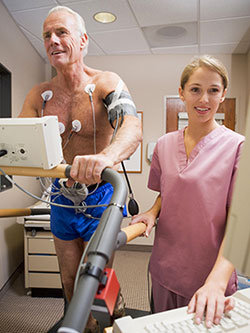Stress Test
 A stress test shows how your heart works during physical activity and can reveal problems with blood flow to and within your heart. Your doctor may recommend a stress test if you have signs or symptoms of coronary artery disease or an irregular heart rhythm (arrhythmia).
A stress test shows how your heart works during physical activity and can reveal problems with blood flow to and within your heart. Your doctor may recommend a stress test if you have signs or symptoms of coronary artery disease or an irregular heart rhythm (arrhythmia).
Exercise Stress Test (Exercise ECG)
An exercise stress test, or exercise ECG, is used to determine how well your heart responds during physical activity. During this procedure, you will exercise on a treadmill at slowly increasing speeds and inclines, while an electrocardiogram (ECG) device measures the electrical signals in your heart.
Stress Echocardiogram
A stress echocardiogram tests your heart’s reaction during periods of rest and exercise. At the beginning of this procedure, a transthoracic echocardiogram (TTE) is performed. You will then exercise on a treadmill at slowly increasing speeds and inclines. A second TTE is performed after exercise is completed. The results of both TTEs are then compared and analyzed.
Nuclear Stress Test
A nuclear stress test involves a standard exercise stress test, in which your blood flow and heart rhythms are monitored during exercise on a treadmill. Before and during physical exercise, a small amount of radioactive material, called tracer, is delivered into the bloodstream via an intravenous (IV) line. A camera then scans your heart and creates pictures that show the tracer traveling through your bloodstream and into your heart. These pictures can show signs of blocked coronary arteries or damage to the heart muscle from a heart attack. The tracer leaves your body within hours.
